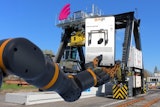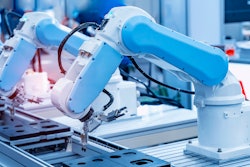
 Dave McCarthy
Dave McCarthyConnected factories and digital transformation initiatives such as industrial Internet of Things (IIoT) projects are disrupting traditional manufacturing processes and operations. As a result, boardrooms across the industry are working to reimagine how they organize and run their businesses, which includes rethinking long-held internal divides – like the gulf between information technology (IT) and operational technology (OT) organizations. The integration and alignment of IT and OT may not seem as important as the new technologies themselves, but connecting the two is, in fact, critical to achieving measurable ROI and timely success with IIoT initiatives.
While Aberdeen recently reported that 70 percent of best-in-class manufacturing companies are converging IT and OT, uniting these inherently different organizations is easier said than done. Fifty-seven percent of professionals with active IIoT projects said that overcoming cultural barriers and organizational silos – which typically start at the top with separate executive leadership – was their biggest obstacle in achieving alignment, according to a recent IoT Institute survey. More than 40 percent also cited other barriers including tension over blurring responsibilities, IT’s failure to understand OT, and a web of complex technology components without a central platform.
From a technology standpoint, IT is generally tasked with supporting business and administrative functions along with network access. Open, interoperable, and rapidly evolving technologies are the norm with primary focus on data processing and network speeds, system availability, and security.
OT interacts with and is responsible for physical equipment that drives the company’s bottom line. This machinery is often highly specialized, extremely expensive, and expected to last for years or decades, sometimes operating virtually nonstop in harsh and remote environments. Automation and control systems tend to be unique to specific equipment and/or manufacturers, and OT can be resistant to changing anything that might affect the delicate balance of keeping production online. With the proliferation of connected equipment, OT departments have begun to adopt more IT-centric technologies such as Ethernet networking and Internet Protocol (IP) communications. However, these efforts are often tightly focused and lack the breadth of vision that can provide value on a much larger scale.
The Value of IIoT
Using real-time equipment data to gain visibility into machine health is often the first thing that drives an IIoT project. Two of the most commonly cited use cases are predictive analytics, which helps flag potential equipment failures before they cause expensive unplanned downtime, and condition-based maintenance, which lowers repair and maintenance costs and extends equipment useful life by servicing equipment only when necessary.
As more connected equipment comes online, these projects can provide value across multiple areas of the business. For instance, an IIoT system can learn the steps and functions required to shut down a production line and reconfigure it for a new task faster, and with greater speed and accuracy, than human operators. This improves output volume and efficiency and is a more economical use of operator time and factory space.
As the system ingests more contextual information from internal and external sources, such as parts and repair applications, it can expand to additional beneficial applications across the business, from improved maintenance and repair processes to better product quality.
However, a joint effort from IT and OT is mandatory for IIoT to grow beyond an individual department or asset population to a company-wide effort with more extensive business value.
Six Steps to Successful IT-OT Convergence
- Get management buy-in. Management support or lack thereof can make or break the success of IT-OT alliances and, by extension, broad-scale IIoT initiatives. Leadership must clearly communicate that the effort is good for the company and insist on collaboration.
- Establish an organization responsible for IIoT. This can be a steering committee with cross-functional representatives or a dedicated organization headed by a Chief Digital Officer. The team should explore anticipated challenges, look for synergies between groups, and evaluate standards and technology options in alignment with existing systems and solutions. The initiative must be treated as an independent entity and not simply an offshoot of an existing cost center.
- Outline clear strategic goals. Brainstorm all avenues of opportunity, thinking inside and outside the business as to how the IIoT initiative might dovetail with others throughout the supply chain. Start by identifying one or two achievable objectives and a timeline for determining success.
- Develop a data management plan up front. Decide what policies, partitions, and different views of data you need to share the data you want and retain the privacy of what you don’t.
- Enlist stakeholder participation. IIoT initiatives can create an entirely new business asset – the company’s data. But this competitive advantage can turn into a liability if this new resource is misused. That’s why security and privacy teams must be intimately involved with IIoT planning. Consult with stakeholders across departments – such as legal, marketing, support, and repair – who can help guide privacy policies and provide insight around new strategies and potential business models.
- Know what you know and what you don’t. Be honest about your strengths and weaknesses. Work with partners who collaborate with your IIoT team and subject-matter experts (SMEs) to determine how and where to apply the appropriate technology.
Align for Success
Aligning IT and OT is a challenge, but it is a crucial step in achieving success with IIoT on an efficient timeline. Besides unifying company vision and direction, breaking down these operational silos can also reduce costs by eliminating redundancies and streamlining operations. In fact, IDC predicts that 35 percent of large global manufacturers with smart manufacturing initiatives will integrate these two organizations to achieve advantages in efficiency and response time by 2019. Companies lacking this level of collaboration may have several successful IIoT pilot projects, but roadblocks like disconnected technologies and struggles over roles and responsibilities make it extremely difficult to scale those smaller initiatives to the degree needed to create a true competitive advantage. Bringing these two groups together, along with partners and stakeholders, is the first step in an ongoing cultural and technological evolution for companies that wish to utilize operational data to gain an edge and achieve measurable business benefit.
Dave McCarthy is senior director of products at Bsquare Corporation.























